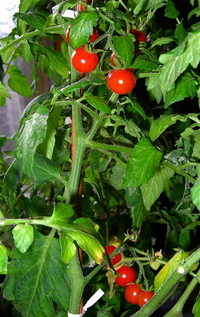Having taken a breather last year, I tackled the tomato front again this year, bringing in the runts from the spring planting, little ones that I’d stuck in pots rather than tossing, plants that were only just starting to flower when I repotted them and brought them inside.
As the photo shows, they do produce tomatoes–that photo is from December, and there have been more tomatoes since then. The thing is, there aren’t many–the photo really gives a false impression, since one assumes that the rest of the plant is similarly laden with ripe fruit. Not so. I seem to remember working myself into an awkward, yogi-worthy twist for that photo, in an attempt to get the only two tomato clumps into the same frame.
Even worse, the tomatoes I do get don’t taste that great. It’s no wonder, I suppose, as our house temperature rarely gets above sixty, and I have no really good sunny windows to offer them.
This year I’ve done my best by them, shaking their blossoms daily to encourage germination (this works), ferttilizing, snipping their tips when they outgrow their stakes, and generally mooning over them. The results?
Of the seven plants I brought inside, one died outright (just pined away for no clear reason, like a girl in a ballad), and the rest, while still producing both flowers and new greenery, are clearly feeling the strain of a winter indoors. They’re afflicted with a variety of pests and diseases I haven’t had the energy to identify, much less fight.
Every year I bring plants in, and every year they cause more trouble than they’re worth. Yes, even I am ready to admit it. My family could have told me (actually, they DID tell me) this years ago, but I’m a little slow. The addict is the last to know or admit she’s got a problem. But I’m finally ready to take that first step, I’m ready now, lord, I see the light: tomatoes belong outdoors, not in.
If anyone knows different, keep it to yourself, if you value your life; there’s no telling what my family might do to someone who re-instills in me the belief that I can raise tomatoes indoors.


 Subscribe to RSS feed
Subscribe to RSS feed


